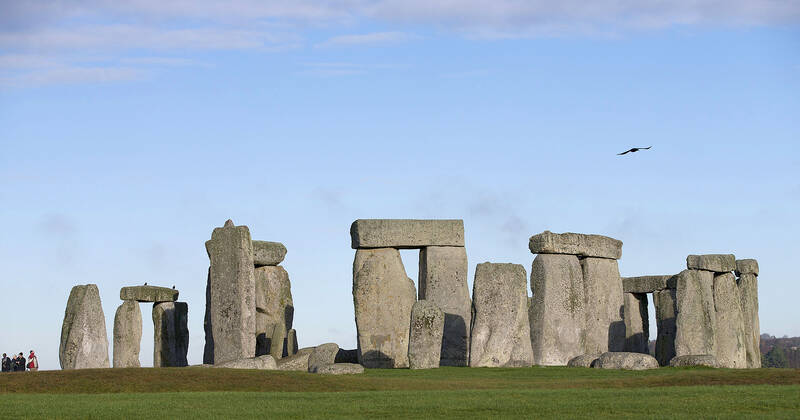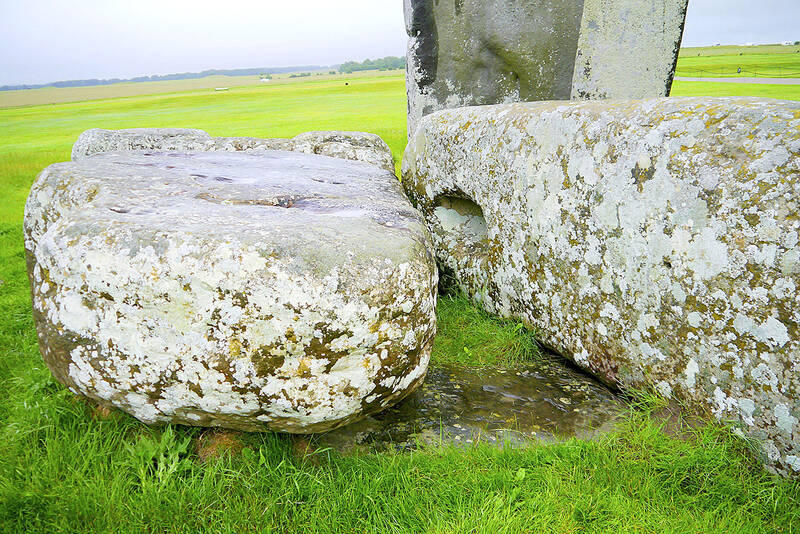For more than a century, archaeologists have known that some of the stones at Stonehenge came from Wales and were transported — somehow — about 200km to the site of the Neolithic monument on Salisbury Plain.
Now, a “jaw-dropping” study has revealed that one of Stonehenge’s central megaliths is not Welsh at all — it is actually Scottish.
In a discovery described by one of the scientists involved as “genuinely shocking,” new analysis has found that the largest “bluestone” at Stonehenge was dragged or floated to the site from the very north-east corner of Scotland — a distance of at least about 750km.

Photo: AP
The astonishing finding that the megalith, which is known as the “altar stone,” was transported by prehistoric people from at least as far as present day Inverness, and potentially from the Orkney islands, “doesn’t just alter what we think about Stonehenge, it alters what we think about the whole of the late Neolithic,” said Rob Ixer, an honorary senior research fellow at University College London (UCL) and one of the experts behind the study, which was published in Nature on Wednesday.
“It completely rewrites the relationships between the Neolithic populations of the whole of the British Isles,” he said. “The science is beautiful and it’s remarkable, and it’s going to be discussed for decades to come … It is jaw-dropping.”
The altar stone is not one of Stonehenge’s famous trilithons — the immense, lintel-topped sarsen stones, which originate from a mere 25km away, and which today form its outer circle. Instead, the huge sandstone block, 5 meters long and weighing 6 tonnes, lies flat and semi-buried at the heart of the monument, trapped under two fallen sarsens and barely visible to visitors.

Photo: AP
Made of a sedimentary rock called old red sandstone, the altar stone is classed as a non-local bluestone and was long thought to have been brought from somewhere in Wales, just as a separate group of Stonehenge’s bluestones are now known to have been quarried in the Preseli Hills in Pembrokeshire.
The altar stone was an outlier, however, and research in recent years led archaeologists, including Ixer, to question whether its origins were Welsh at all.
The new study, which involved experts from Curtin University in Perth, Australia; the University of Adelaide; Aberystwyth University; and UCL, aimed to find out more by examining the stone’s chemical composition and the age of minerals within it.
Taken together, these give a characteristic “age fingerprint” to the sandstone, said Nick Pearce, a professor of geography and earth sciences at Aberystwyth who is another of the report’s co-authors.
“With that age fingerprint, you can match it to the same sort of rocks around the UK — and the match for the age fingerprint was a dead ringer for the Orcadian Basin in north-east Scotland,” he said. “It was completely unexpected to us.”
The finding may be astonishing, but the science is not controversial, said Pearce. “It’s very, very well-established science. It’s not something that people can look at say: ‘Oh no, that can’t be right.’”
The odds of the stone coming from elsewhere are “fractions of a percent,” he said.
For many, the biggest question will be one not explored in detail in the scientific paper: how on earth did Stonehenge’s builders transport the giant stone from Scotland to Wiltshire?
“Given major overland barriers en route from north-east Scotland to Salisbury Plain, marine transport is one feasible option,” said the lead author, Anthony Clarke, of Curtin University.
But the archaeologist and writer Mike Pitts, who was not involved in the research but whose work on Neolithic monuments includes the book How to Build Stonehenge, said he believed it was more likely the stone was dragged overland than floated by sea.
“If you put a stone on a boat out to sea, not only do you risk losing the stone — but also nobody can see it,” he said.
Instead, a land journey, perhaps taking many years, would engage people en route, with the stone “becoming increasingly precious … as it travels south”, he added.
Impossible as it may seem today, an overland journey “was easily within the reach of Neolithic technology.”
“[The study] is exciting and it’s so significant,” Pitts said. “It’s long been known that the bluestones come from Wales, but this identifies links with a quite different part of Britain, and significantly more distant from Stonehenge. So it suggests that the site was known not just to people in the south, but over a much wider area — and that opens suggestions for the whole way we think about Neolithic Britain.”

June 9 to June 15 A photo of two men riding trendy high-wheel Penny-Farthing bicycles past a Qing Dynasty gate aptly captures the essence of Taipei in 1897 — a newly colonized city on the cusp of great change. The Japanese began making significant modifications to the cityscape in 1899, tearing down Qing-era structures, widening boulevards and installing Western-style infrastructure and buildings. The photographer, Minosuke Imamura, only spent a year in Taiwan as a cartographer for the governor-general’s office, but he left behind a treasure trove of 130 images showing life at the onset of Japanese rule, spanning July 1897 to

One of the most important gripes that Taiwanese have about the Democratic Progressive Party (DPP) is that it has failed to deliver concretely on higher wages, housing prices and other bread-and-butter issues. The parallel complaint is that the DPP cares only about glamor issues, such as removing markers of Chinese Nationalist Party (KMT) colonialism by renaming them, or what the KMT codes as “de-Sinification.” Once again, as a critical election looms, the DPP is presenting evidence for that charge. The KMT was quick to jump on the recent proposal of the Ministry of the Interior (MOI) to rename roads that symbolize

On the evening of June 1, Control Yuan Secretary-General Lee Chun-yi (李俊俋) apologized and resigned in disgrace. His crime was instructing his driver to use a Control Yuan vehicle to transport his dog to a pet grooming salon. The Control Yuan is the government branch that investigates, audits and impeaches government officials for, among other things, misuse of government funds, so his misuse of a government vehicle was highly inappropriate. If this story were told to anyone living in the golden era of swaggering gangsters, flashy nouveau riche businessmen, and corrupt “black gold” politics of the 1980s and 1990s, they would have laughed.

In an interview posted online by United Daily News (UDN) on May 26, current Chinese Nationalist Party (KMT) Chairman Eric Chu (朱立倫) was asked about Taichung Mayor Lu Shiow-yen (盧秀燕) replacing him as party chair. Though not yet officially running, by the customs of Taiwan politics, Lu has been signalling she is both running for party chair and to be the party’s 2028 presidential candidate. She told an international media outlet that she was considering a run. She also gave a speech in Keelung on national priorities and foreign affairs. For details, see the May 23 edition of this column,